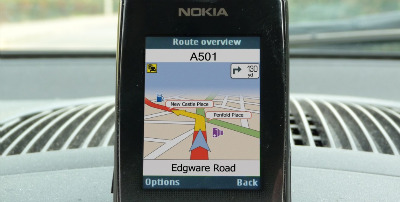A pioneer in online and smart phone mapping, Israel’s Telmap navigation tools are used by half the smart phone users in Europe and the Middle East.

One of the things that make smart phones smart is their ability to help you to get where you’re going, using navigation maps. Navigation applications – showing you how to get from point A to point B – are standard on iPhones, Nokia handsets, Blackberrys and others and are among users’ favorite apps.
While few of us are aware of it, if you’re traveling in Europe, the Middle East, and parts of the US, and taking advantage of your navigation app, chances are high that it’s Israel’s Telmap that’s helping you to reach your destination.
Before there was Google Maps, before there was handheld GPS, there was Telmap, one of the pioneers in online and smart phone mapping. The company was formed in 2000, says Ronen Sofer, Telmap’s CTO, and has been at the forefront of every major development in online mapping since then – to the extent that technology analysis firm Canalys said earlier this year that over half the smart phone users in Europe and the Middle East use applications developed by Telmap.
“We started out as an online mapping application, developed over a decade ago in a garage by a couple of technology freaks,” Sofer tells ISRAEL21c. At the time, the only map game in town was Mapquest, which was unwieldy for most users. When you requested a map, you would download a picture of the map you requested in gif or jpg format, often waiting a long while for files that took their time downloading over the then-common dial-up modems.
A tool for Europe’s major cell phone providers
“Telmap’s application sent the information as data, so downloading it was much faster,” says Sofer. That put the company on the map and it’s been working on innovations to its core applications ever since, enhancing them for use with the GPS built into today’s smart phones.
Users can get Telmap applications in one of two ways – either as a branded product from their cell phone service provider, or, on some platforms, as a direct download from an app store. The company concentrates mostly on developing ‘white label’ versions of its applications, which its partners brand for their own customers, but it also releases similar applications under its own name. Managing the potential conflict – which one will users prefer? – is a feat few companies can execute, but Telmap is agile enough to handle both channels.

Among the company’s customers are the biggest cell phone service providers in Europe: Vodaphone and Mobilcom in Germany, the UK and Spain, 02 and Orange in the UK, Orange and SFR in France, Spain’s Telefonica, all four Israeli providers (Orange, Cellcom, Pelephone, Mirs), Vodacom in South Africa, and Optus in Australia. In addition, the company provides applications for the Boost Network (a division of Sprint) in the US, and USACell in Mexico. They’ve also spread a wide net over much of Asia (except for China).
“It works out for everyone,” says Sofer. “We get a sale, and the companies get an application that brings the latest technology to their customers, encouraging them to remain as customers and use additional services.”
Part of the service Telmap provides is developing native-language versions of its main Navigator application for all service providers it works with. Indeed, there are dozens of versions of the application in different languages – including Arabic, for use by Arabic speaking customers of the Israeli phone companies, and customers elsewhere in the Middle East.
Inroads into the US market
The only major market Telmap hasn’t cracked completely is the US market, where Sofer says a couple of major players are very well entrenched. Still, he reports that the company has made some inroads there, and is working on developing partnerships that will enhance its value to US cell phone service providers.
In its latest deal, for example, Telmap partnered with the Lonely Planet guide online version; users who click on a site on their Navigator map can now receive touring information from a Lonely Planet guide for the site.
Indeed, enhancing maps with data – information about gas stations, restaurants, tourist sites, etc. – is an important feature for any mapping application today, and the company’s Telmap5 application offers all sorts of useful information for users, along with the ability to connect with others on the network.
“Version 5 is a complete application that will feature almost anything required by a user on the go, from parking information, where to take the kids, restaurant search, etc.,” says Sofer. It also offers location-based social features, such as allowing users to communicate over the network about traffic conditions.
While it’s a great idea, Telmap is not the first. Another Israeli company called Waze is the pioneer in ‘traffic crowdsourcing,’ but Sofer believes that Telmap’s take on the service is better.
Gearing up for a “revolutionary” future
“Waze showed there is traction for including the community in building traffic maps, but I think Telmap has more and better resources, and we can give customers better tools to get and use the information,” he insists. The same holds true for the other data offered with version 5. Telmap plans to wield its considerable influence and presence in markets around the world, gathering the information that will make its mapping application stand out.
A sign of the superiority of Telmap’s products and its excellent work atmosphere (some 200 people work in the company’s Herzliya headquarters, and there is very little turnover, Sofer relates) is that, according to Sofer, “2009 was one of our best years,” even though it was a tough year for so many other businesses.
He attributes the company’s success to the increased awareness and demand for smart phones and the services they provide. “Users discovered that despite the recession, there was much value to be had in the services offered by smart phones,” so they flocked to them, he asserts.
Meanwhile, Sofer and Telmap are gearing up for a future the CTO calls nothing short of “revolutionary.” Location-based and social applications, such as Foursquare, Twitter and Facebook are having a huge impact on users, and Telmap has been busy integrating their functionality into applications offered by the company.
Eventually, he says, “users will have location information in all aspects of their phone use – applications and even phone calls will be more social, and more local. And we plan on being at the leading edge of that revolution.” The company, with its API, is actively looking for more partners. “We have, in our technology, the glue that holds it all together. Our hope is that eventually, everything you do on your cell phone will have a little Telmap map next to it,” he concludes.












